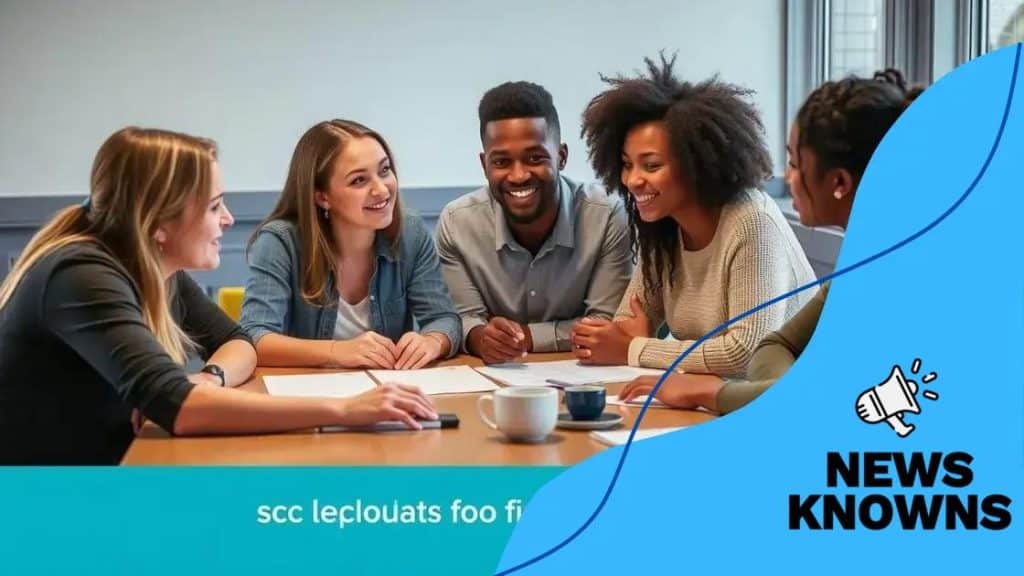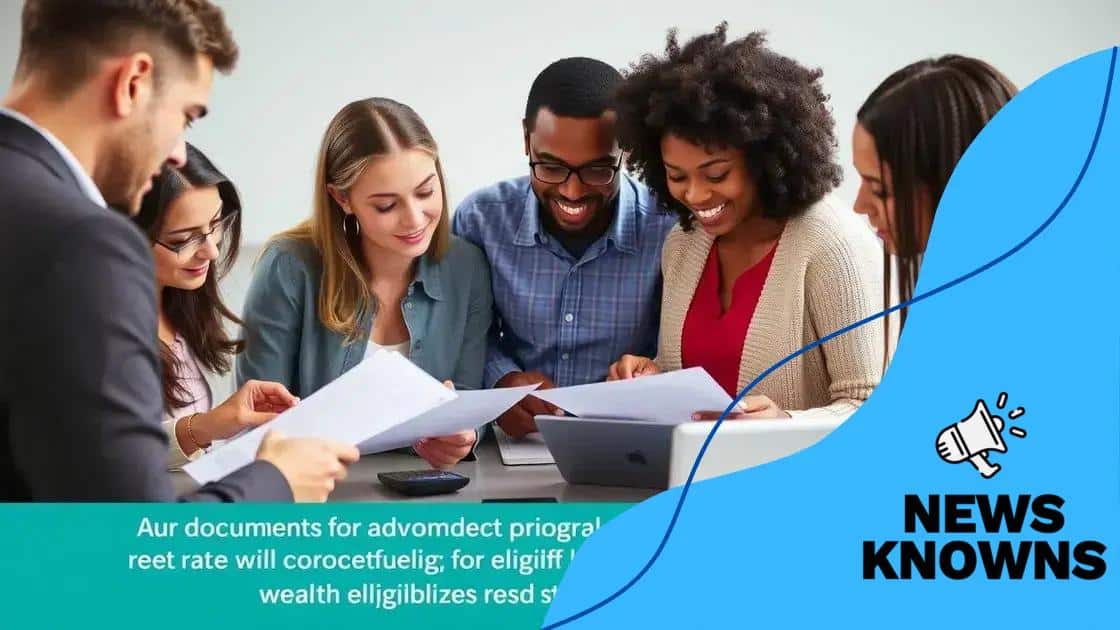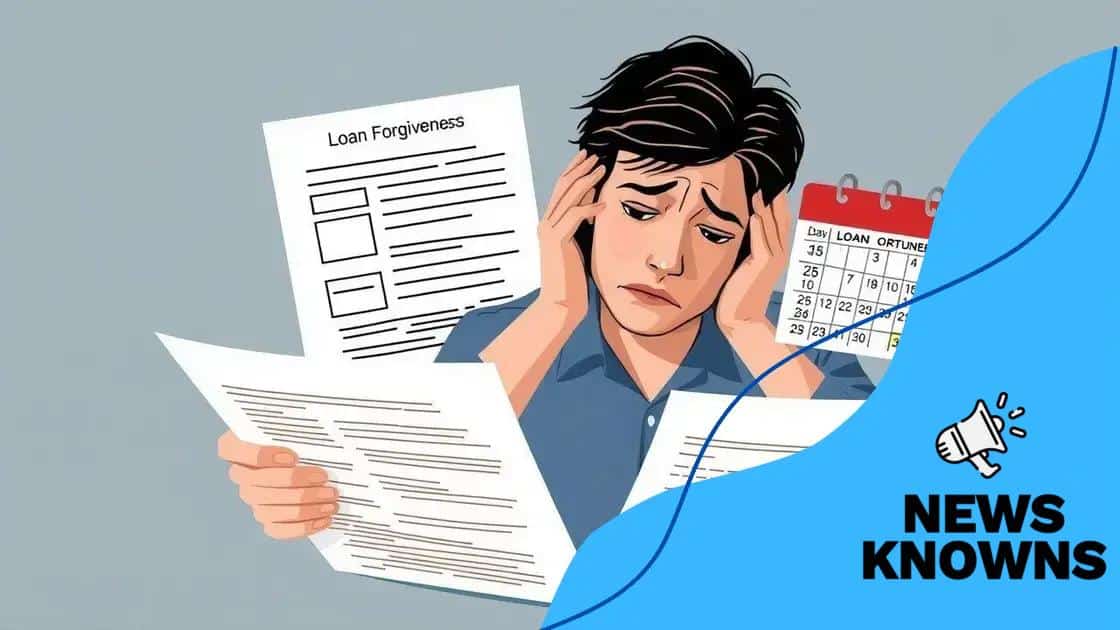How to navigate the new student loan forgiveness programs

Anúncios
Understanding how to navigate the new student loan forgiveness programs involves knowing eligibility criteria, the application process, common pitfalls, and recent legislative changes that can impact your options for financial relief.
How to navigate the new student loan forgiveness programs can be a daunting task for many. With various options available, knowing where to start is crucial. Have you considered how these programs might ease your financial stress?
Anúncios
Understanding student loan forgiveness programs
Understanding student loan forgiveness programs is crucial for many borrowers seeking financial relief. These programs can offer significant help, easing the burden of student debt.
There are several types of forgiveness options available. Each program has different eligibility criteria, so it’s essential to grasp the basics.
Types of Forgiveness Programs
Common types of student loan forgiveness programs include:
Anúncios
- Public Service Loan Forgiveness (PSLF): Designed for borrowers working in public service jobs.
- Teacher Loan Forgiveness: Available to teachers who work in low-income schools.
- Income-Driven Repayment (IDR) Forgiveness: After 20-25 years depending on the plan.
Each of these options can reduce or eliminate the remaining balance of your loans under specific circumstances. Understanding these differences can help you choose the best path towards relief.
Eligibility Criteria
To qualify for any of these programs, you must meet specific requirements. These may include:
- The types of loans you have.
- Your employment status and job type.
- The number of payments made under your repayment plan.
It is important to gather the right documentation and maintain accurate records to support your application. Staying organized can make the process smoother.
Furthermore, keep in mind that some forgiveness programs may change over time. It’s wise to stay updated with the latest information from federal resources or a financial advisor.
As you explore these options, consider reaching out for help if needed. Educating yourself on the various programs can empower you to make informed decisions and potentially save you thousands.
Overall, understanding student loan forgiveness programs is an important step towards alleviating financial stress. By familiarizing yourself with your options, eligibility, and requirements, you can navigate this complex landscape with greater confidence.
Eligibility criteria for forgiveness

Eligibility criteria for forgiveness programs is a vital aspect of understanding how to benefit from student loan relief. Each program has specific requirements that borrowers must meet to qualify.
Generally, these criteria can include your loan type, employment status, and the number of qualifying payments made. It is important to carefully review these factors to ensure you are eligible.
Loan Types
To be considered for certain forgiveness programs, your loans must fall under specific categories:
- Federal Direct Loans: Most forgiveness programs require you to have federal direct loans.
- Federal Family Education Loans (FFEL): These may be eligible if consolidated into a direct loan.
- Perkins Loans: Eligibility can vary, so check with your loan servicer.
Understanding your loan type is essential as it affects your eligibility for forgiveness options.
Employment Status
Your job can also play a crucial role in determining eligibility:
- Public Service Employment: Many programs are designed for those working in public service jobs.
- Teaching in Low-Income Areas: Teachers in specific schools may qualify for additional forgiveness.
- Non-profit Organizations: Employment with qualifying non-profits can lead to forgiveness options.
Make sure to know the specific requirements tied to your employment status as they vary from one program to another.
Additionally, you will often need to make a specific number of qualifying payments. This is a common requirement for most forgiveness programs. Tracking these payments is essential to avoid any missteps.
Lastly, keep in mind that some changes in federal policies can affect eligibility. Regularly checking updates from reputable sources can help you stay informed and prepared.
Steps to apply for loan forgiveness
Steps to apply for loan forgiveness can seem overwhelming, but breaking it down makes it easier. Each program has its own application process, but a few general steps can guide you through.
First, gather important documents that will be required during the application process. This can include your loan information, employment verification, and income documentation. Keeping everything organized is key.
Understanding the Application Process
Next, familiarize yourself with the specific process for the forgiveness program you are interested in. Many programs will require you to fill out a specific application form.
- Public Service Loan Forgiveness: Complete the PSLF application. Make sure to include your employer certification.
- Teacher Loan Forgiveness: Submit the Teacher Loan Forgiveness Application before the deadline.
- Income-Driven Repayment Forgiveness: Ensure you are enrolled in an IDR plan and submit your annual income verification.
Once you have the necessary forms filled out, submit your application to the appropriate body. This could be your loan servicer or a government agency, depending on the program.
Follow Up on Your Application
After submitting your application, it’s important to follow up. You should confirm that your application was received and is being processed. This can prevent delays.
Additionally, keep track of any communication you receive regarding your application status. It is vital to respond quickly to any requests for further information. Being proactive can help ensure a smooth process.
As you await a decision, stay informed about your eligibility progress. Understanding your rights and the timelines involved can help set clear expectations.
Applying for loan forgiveness can be a significant step toward financial freedom. By following these clear steps, you can navigate the process more effectively.
Common pitfalls and how to avoid them

Common pitfalls and how to avoid them is important for anyone navigating the loan forgiveness process. Understanding these pitfalls can save you time and stress.
Many borrowers make mistakes that delay their application or even lead to denial. It’s crucial to recognize these errors early. Here are a few common pitfalls.
Incomplete Applications
One frequent issue is submitting incomplete applications. It’s vital to review your application carefully before sending it in. Missing documents can lead to processing delays.
- Check required documents: Ensure you’ve included all necessary paperwork.
- Verify your information: Mistakes or typos can affect your application.
- Follow instructions: Adhere to the guidelines provided by the program.
Each detail matters in the application process, so make sure everything is accurate and complete.
Ignoring Deadlines
Another common pitfall is missing deadlines. Each forgiveness program has specific timelines that you must follow. Failure to meet these deadlines can result in forfeiting your chance for forgiveness.
Stay organized by marking important dates on your calendar and setting reminders. This proactive approach can keep you on track and ensure you do not miss any critical deadlines.
Not Keeping Accurate Records
Failing to maintain accurate records can also hinder your progress. Keep track of all your payments and any correspondence you have regarding your loan. This information can be essential if questions arise about your application.
- Document payment dates: Note when payments are made.
- Save communication: Keep all emails or letters related to your loan.
- Track employment changes: Report any changes in your job status.
Good record-keeping will make it easier to verify your eligibility for forgiveness and can speed up the approval process.
By being aware of these common pitfalls, you can navigate the loan forgiveness process more smoothly. Avoiding these mistakes will help ensure that you stay on the right track toward financial relief.
Impact of recent changes in legislation
Impact of recent changes in legislation regarding student loan forgiveness can have significant effects on borrowers. Staying informed about these changes is crucial for making sound financial decisions.
Recent legislation has introduced various updates that can alter the landscape of forgiveness programs. These changes can affect eligibility, application processes, and the types of loans that qualify.
Eligibility Changes
One major impact has been changes in eligibility criteria for some forgiveness programs. This can include:
- Broader eligibility: Some programs have expanded to include more borrowers, especially those in public service roles.
- Loan type revisions: Updates may now include different loan types that were previously excluded.
- New employment requirements: Certain jobs may now qualify borrowers who did not meet previous criteria.
These modifications might open doors for many who previously felt excluded from applying.
Application Process Adjustments
The application process has also seen changes. New forms or guidelines may be introduced, making it essential to stay current with the required steps.
Ensuring that you have the latest forms is important to avoid unnecessary delays. Regularly checking official resources can help you keep up with these changes.
Funding and Federal Support
Additionally, recent legislation may provide new funding for forgiveness programs. Increased financial resources can help ensure that programs are sustained and accessible.
This support also aims to alleviate the burden of student debt for borrowers who qualify. The more robust funding can lead to more efficient processing times and improved program stability.
As you navigate these changes, it’s beneficial to stay engaged and informed. Understanding how recent changes in legislation can impact your options will help you make the most of the available forgiveness programs.
In conclusion, understanding the ins and outs of student loan forgiveness programs is vital for borrowers. By staying informed about eligibility, common pitfalls, and recent legislative changes, you can better navigate the application process and make the most of your options. Keeping meticulous records and meeting deadlines are crucial steps in ensuring a smooth experience. Ultimately, educating yourself about these programs can lead to significant financial relief and pave the way for a brighter financial future.
FAQ – Frequently Asked Questions about Student Loan Forgiveness
What are the requirements to qualify for loan forgiveness?
Eligibility typically includes having federal student loans and working in a qualifying job, such as public service or teaching in low-income areas.
How do I start the application process for loan forgiveness?
Begin by gathering your loan information and required documents, then complete the application specific to the forgiveness program you’re interested in.
What common mistakes should I avoid when applying?
Avoid incomplete applications, missing deadlines, and failing to keep accurate records of your payments and employment status.
How do recent legislative changes affect my eligibility?
Recent changes may expand eligibility criteria, introduce new forgiveness options, and affect the types of loans that qualify, so it’s essential to stay updated.





